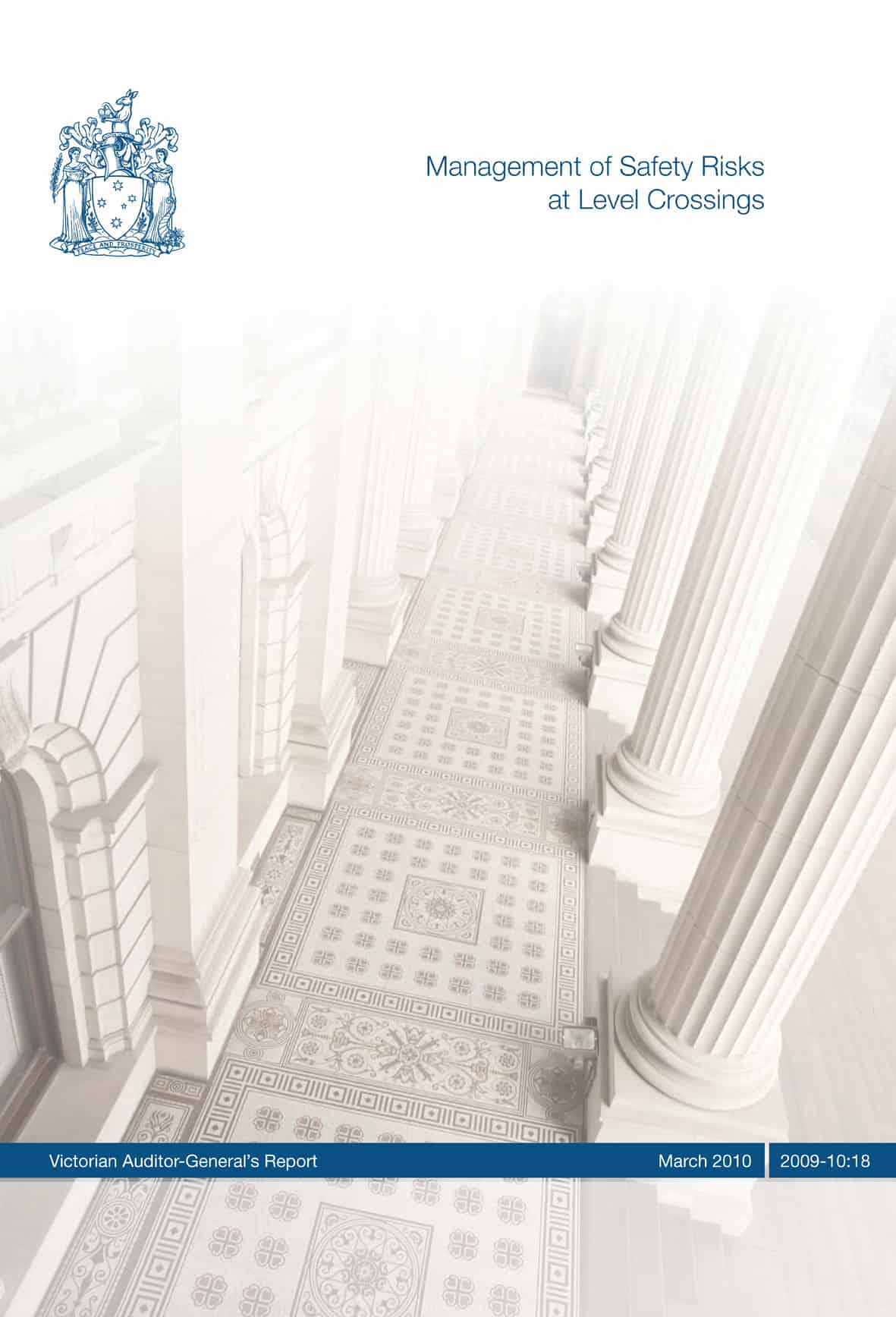 The Victorian Government is likely to say the Auditor-General’s report into “Management of Safety Risks at Level Crossings“, released on 24 March 2010, supports the government’s initiatives. This is true but the report says much more than just describing the State Government’s efforts as “satisfactory”. (If my child’s report card said satisfactory, I would be talking to the teacher about why the performance was only “satisfactory”)
The Victorian Government is likely to say the Auditor-General’s report into “Management of Safety Risks at Level Crossings“, released on 24 March 2010, supports the government’s initiatives. This is true but the report says much more than just describing the State Government’s efforts as “satisfactory”. (If my child’s report card said satisfactory, I would be talking to the teacher about why the performance was only “satisfactory”)
The report summary says the following:
“The rate of progress in improving safety and reducing accidents has been satisfactory. There are, however, elements of the risk management framework and its application that can be improved.”
- “improving how the committee is informed of the views of the rail managers, who run train services and maintain the infrastructure, about their risks and priorities
- assembling information that will allow the committee to effectively manage and monitor the delivery of the Towards Zero strategy
- improving the understanding of what causes level crossing collisions.” [link added]
Clearly the Parliamentary committee is not getting the full risk story from the rail managers. This lack of complete information is hindering the committee’s ability to monitor the performance targets of the rail managers.
The report specifically says:
“The information the department publishes is not sufficient to understand how its plans and programs are progressing and how successful they have been in delivering on the department’s objectives.”
The report summary says that the Department of Transport seems to have introduced a remediation program without fully understanding the costs and the benefits of the program, although it has introduced assessment measures after the program’s commencement. The report says
“The department does not have an accurate grasp of the cost-effectiveness of the treatments it deploys. Whilst it mostly understands the costs, it has not adequately evaluated the benefits.”
“The department has not adequately assessed treatments before their deployment, or once deployed, evaluated them.”
The full recopmmendations of the Auditor-General’s assessment are:
“The Department of Transport should:
- Work with the rail managers to strengthen the processes it uses to inform the committee about the rail managers’ views when making decisions about level crossing priorities and upgrades.
- Lead the road and rail managers to develop a detailed, three-year plan that provides an adequate basis for managing and monitoring the Towards Zero strategy.
- With Public Transport Safety Victoria’s support, agree on and document the actions needed to deliver a better understanding of level crossing collisions as part of the detailed plan underpinning the Towards Zero strategy.
- Review the legislation and develop recommendations to improve the effectiveness of the level crossing closure process.
- Understand why the charges for level crossing upgrades completed by different organisations have varied, with the view to improving efficiency.
- Publish an analysis of the issues raised by its survey of level crossings, identifying the works required, agency responsible and an estimate of the cost.
- Improve the approach to assessing risk mitigation treatments before their deployment and evaluating treatments once deployed.
- Improve the way it reports on level crossing safety.”
One reason for the justification in a “satisfactory” grading can be seen by a comparison of VicTrack’s performance in December 2005, with similar activity in December 2008:
“For example, in December 2005, VicTrack contracted a package of 11 level crossing upgrades in regional Victoria specifying delivery by June 2006. Of these upgrades:
- none were commissioned by June 2006
- two were completed in the last quarter of 2006
- three were completed in 2007
- five were completed by July 2008
- one is scheduled for completion in March 2010………..
This contrasts with VicTrack’s more recent performance. For example we examined two of the contracts awarded in 2008. From the 26 crossing upgrades included:
- one was completed early
- 14 were completed on time
- seven were completed within 35 days of the planned date
- three were completed within 90 days of the planned date
- one was completed 150 days after the planned date.”
Why such a dramatic change? The same political party has been in government in Victoria over that time. The maintenance and construction is being coordinated by the same organisation.
Although there had been other level crossing fatalities in Victoria during that time, the motivation for change came from the political impact of the deaths of 11 people in the Kerang rail disaster on 5 June 2007.
Significance
Level crossings are a useful case study for safety managers for several reasons:
- The need to constantly update safety technology.
- The threat to mobile workplaces such as trains and trucks.
- The need to integrate safety at a design phase.
What various investigations, parliamentary committees and auditor reports show in Australia is that government is slow to respond to hazards and that, when it does, it sometimes introduces control measures that have not been properly considered prior to implementation. It can be said that this situation is no different to that which created level crossings in the first place decades ago.
There are many examples of this governmental process in other programs in recent times, such as insulation installation in Australia. But it does not mean that this level of progress is inevitable and it is up to safety professionals and safety advocates to not only appear at committees and make submissions but to actively lobby and campaign the rail companies and the government to act on the eradication of the unnecessary risk of level crossings.
